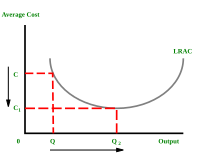
Photo from wikipedia
A multi‐scale computational framework suitable for designing solid lubricant interfaces fully in silico is presented. The approach is based on stochastic thermodynamics founded on the classical thermally activated 2D Prandtl–Tomlinson… Click to show full abstract
A multi‐scale computational framework suitable for designing solid lubricant interfaces fully in silico is presented. The approach is based on stochastic thermodynamics founded on the classical thermally activated 2D Prandtl–Tomlinson model, linked with first principles methods to accurately capture the properties of real materials. It allows investigating the energy dissipation due to friction in materials as it arises directly from their electronic structure, and naturally accessing the time‐scale range of a typical friction force microscopy. This opens new possibilities for designing a broad class of material surfaces with atomically tailored properties. The multi‐scale framework is applied to a class of 2D layered materials and reveals a delicate interplay between the topology of the energy landscape and dissipation that known static approaches based solely on the energy barriers fail to capture.
Journal Title: Advanced Materials Interfaces
Year Published: 2021
Link to full text (if available)
Share on Social Media: Sign Up to like & get
recommendations!